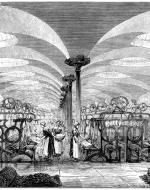Created by Grace Rogers on Sat, 10/30/2021 - 01:52
Description:
I was intrigued by the character Bessy in Elizabeth Gaskell's North and South, and her representation of the detrimental effects of the industrial revolution on the working class. The photo I have shared depicts a flax mill, similar to a cotton mill where Bessy would have worked in. As we can see it is extremely crowded both with workers and equipment, which leads to the infamous heath complications within factories. The main illness contracted in cotton and flax mills was byssinosis, the blockage of the lungs caused by the cotton and flax particles within the air of these poorly ventilated and crowded spaces. Bessy explains the effects of byssinosis in Chapter XIII , saying "Little bits, as fly off fro’ the cotton, when they’re carding it, and fill the air till it looks all fine white dust. They say it winds rounds the lungs, and tightens them up. Anyhow, there’s many a one as works in a carding-room, that falls into a waste, coughing and spitting blood, because they’re just poisoned by the fluff." As Bessy is dying from this condition, she also is constantly fatigued and depressed by her fate but continues working until she passes to support her family.
In Carolyn Tuttle's "Child Labor during the British Industrial Revolution", she reports on the British Census of 1851, stating "The employment of children in textile factories continued to be high until mid-nineteenth century... By 1851 the three most common occupations for boys under 15 were Agricultural Labourer (82,259), Messenger (43,922) and Cotton Manufacture (33,228) and for girls it was Domestic Servant (58,933), Cotton Manufacture (37,058) and Indoor Farm Servant (12,809) (1852-53[1691-I]LXXXVIII, pt.1)". Bessy would have been part of this demographic being one of approximately 37,000 girls under 15 in the cotton manufacturing business, as she was about 18 when North and South was released in1855. She is a prime example of the stresses and unfair conditions put upon these working-class children during the Industrial Revolution of Britain. The need to exchange her suffering for the well-being of her family, and eventually lose her life, was a widespread issue affecting countless British families. Even though the Factory Act was put into place in 1833 in an attempt to ease the suffering of these children, conditions were far from ideal and would continue to be so until children were able to not be held accountable for their family's finance.
Works Cited: Gaskell, Elizabeth. “XIII.” North and South, vol. 1 & 2, Chapman and Hall, Picadilly, London, 1855, pp. 58–58.
Tuttle, Carolyn. “Child Labor during the British Industrial Revolution”. EH.Net Encyclopedia, edited by Robert Whaples. August 14, 2001.
http://eh.net/encyclopedia/child-labor-during-the-british-industrial-revolution/


